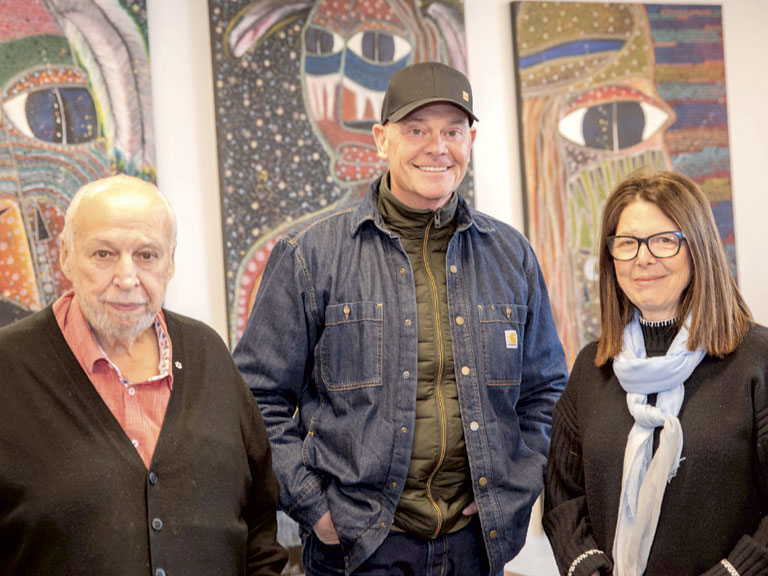County News
Atomic Reaction

Documentary movie reveals Canada’s role in atomic warfare
Motorists driving along Highway 401 just west of Port Hope can see a mound of earth rising on the south side of the highway that is the visible evidence of a massive ongoing cleanup effort. There’s a thread stretching from Great Bear Lake in the Northwest Territories in the 1930s, through Port Hope and on to Los Alamos, Hiroshima and Nagasaki during the Second World War, and back to this mound that is explored in the new documentary movie Atomic Reaction, which will be screened this Sunday at the Regent Theatre. The film is produced by County residents Bernie Finkelstein and David Hatch, and is directed by another County resident, Michèle Hozer. This film had its beginning about a decade ago when Mr. Finkelstein screened his film Pacing the Cage about the life of musician Bruce Cockburn. Mr. Hatch approached him with the idea of making another music film, but Mr. Finkelstein wanted a different challenge. The conversation eventually turned to the community of Chalk River, which is located near the site of Canada’s first nuclear reactor. “During the conversation about Chalk River, Port Hope came up, and the question about the clean-up. We started researching the clean-up, and the deeper we got into the situation, the story just exploded,” said Mr. Finkelstein. “Ninety per cent of what is in the film, I knew nothing about the day we started.” It was a long and slow process to do the research. “It was like peeling back an onion,” said Mr. Hatch. “We went in thinking we’d start looking at the idea of the clean-up, and the more we dug into that, the more we got talking to people who were telling us all kinds of things. It took about two years before we started making the connection to the Manhattan Project.”
The story begins in the 1930s with the discovery of pitchblende ore deposits along the shore of Great Bear Lake, just 16 miles from the Arctic Circle, by Gilbert LaBine. He was interested in the radium deposit within the ore, which was a rare and much sought-after commodity. The fact that the ore contained large amounts of uranium did not become important until years later. Mr. LaBine obtained a pea canning factory in Port Hope and converted it to a refinery to extract radium from the pitchblende ore. Thus was born the Atomic Highway from Great Bear Lake to Port Hope, a water and rail route spanning some 6,000 kilometres.
This was also the beginning of Port Hope’s soil contamination of historic low level radioactive waste. Tonnes of ore had to be processed to extracts miniscule amounts of radium. The sand-like remains were first piled up around the refinery, then around the harbour and beaches, and finally around the community as landfill.
The story takes a significant turn after the radium extraction became unprofitable in the late 1930s. The phenomenon of nuclear fission was discovered by German scientists in 1938, and a number of scientists in America saw the possibility that Nazi Germany could develop a nuclear weapon. They sent a letter to then president Franklin D. Roosevelt, but no action was taken until America entered the Second World War after Pearl Harbour. The signing of the Quebec Agreement in 1943 by President Roosevelt and British prime minister Winston Churchill led to Canada’s top secret role in providing uranium for the Manhattan Project. Pitchblende ore from Great Bear Lake was now processed to extract uranium in Port Hope. That refined metal was then shipped through Buffalo and on to Los Alamos, where it was incorporated into bombs that would eventually be used against the Japanese in Hiroshima and Nagasaki.
The first concerns about radioactive contamination in Port Hope were raised in the 1970s, but it wasn’t until about 2010 that clean-up efforts started in earnest. The film explores why it took so long for the problem to be addressed. Initial estimates for the cost were around $300 million, then later increased to $1.2 billion, and are now estimated to be $2.6 billion. It is estimated there are two million cubic metres of soil to be sequestered, and more than 50,000 trees are at risk of removal. The film features Brian Bromley, the great-grandson of Gilbert LaBine, and Cindy Kenny-Gilday, a Déne Elder whose father was one of the ore carriers, as well as Port Hope residents and clean-up representatives. The film has been screened at the Durham Region International Film Festival as well as in Rio de Janeiro, where it received an Honourable Mention. Ms. Hozer is thrilled that the film will be screened at the Regent. “This film is really a labour of love for the producers. To be in a theatre and to see the reaction is probably the best part of filmmaking. It’s rare now to have that collective experience. To see people react to the film is the most rewarding part of doing this,” she said. The film will be shown at the Regent Theatre on Sunday at 4 p.m. It will be streamed on CBC GEM on January 10, 2025.

Comments (0)